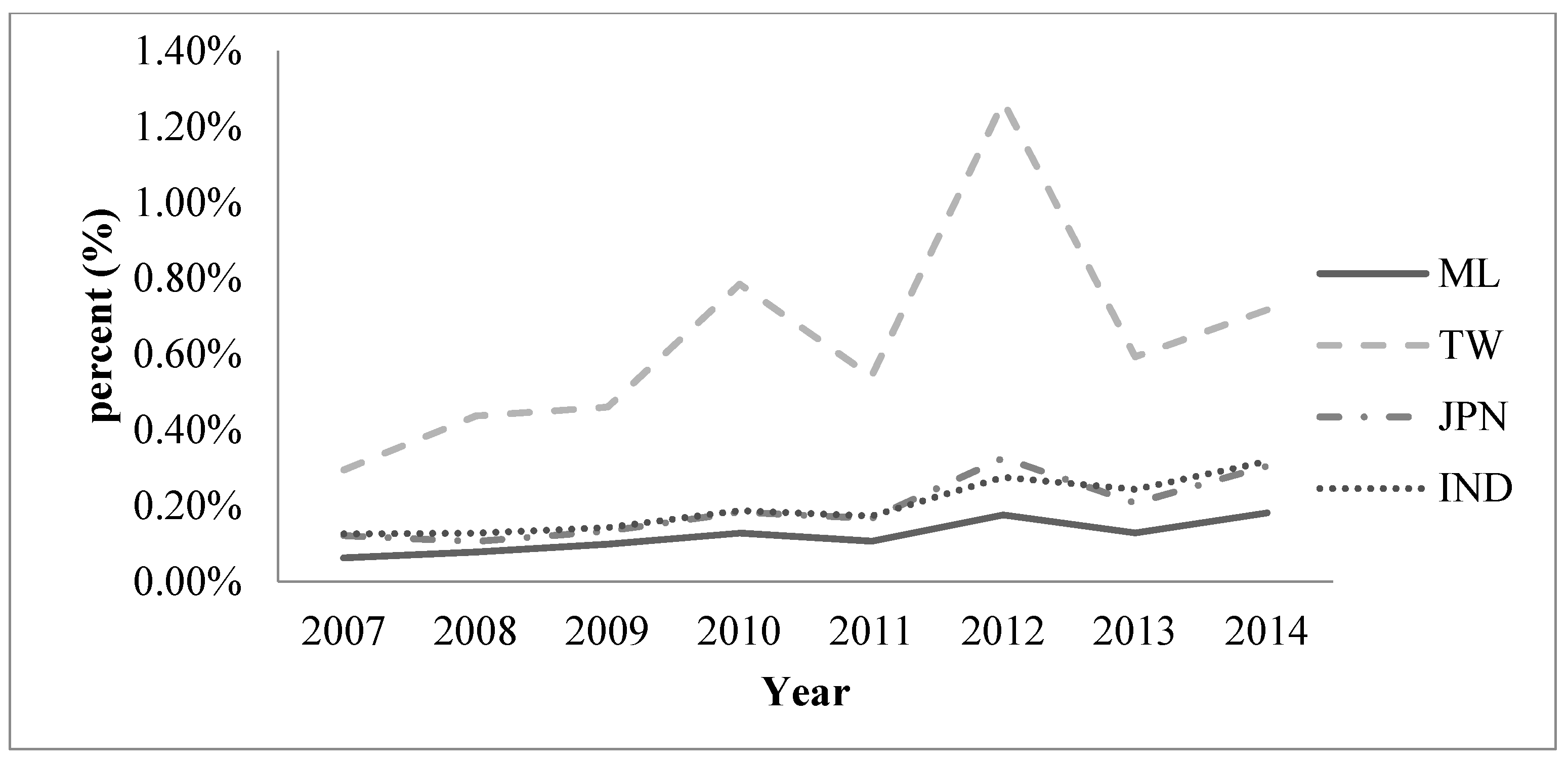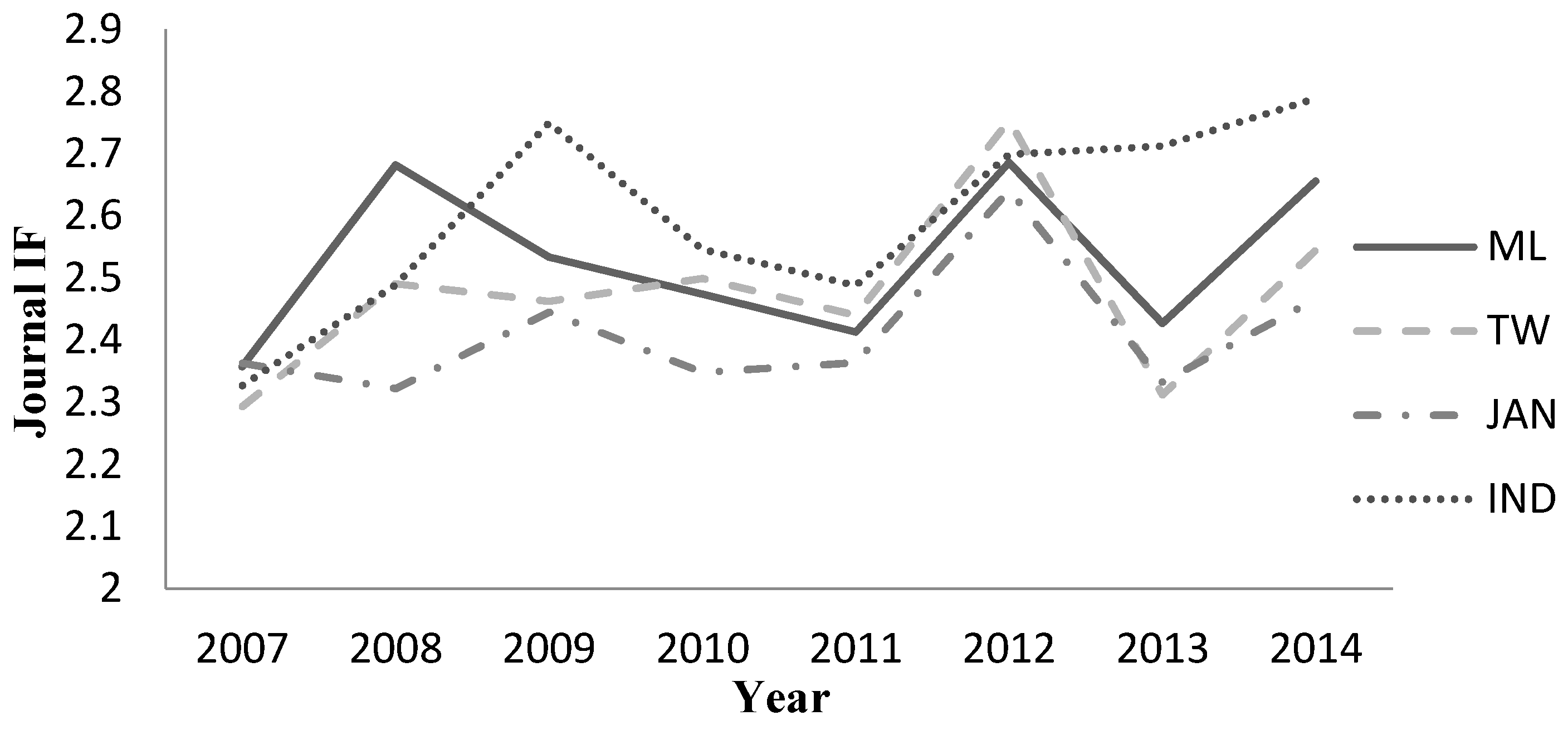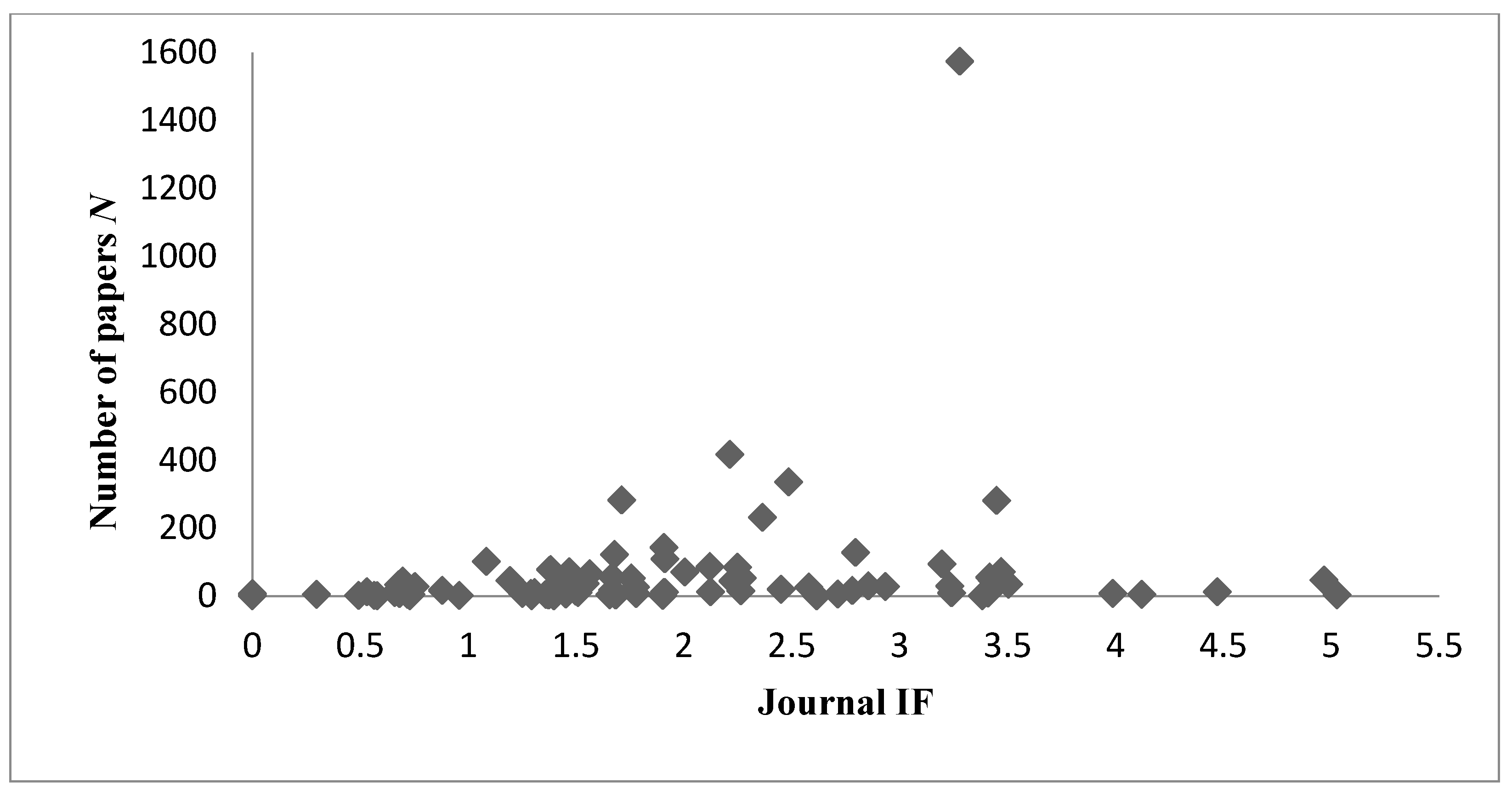A Comparative Study of Scientific Publications in Health Care Sciences and Services from Mainland China, Taiwan, Japan, and India (2007–2014)
Abstract
:1. Introduction
2. Materials and Methods
Statistical Analyses
3. Results
3.1. Total Number of Scientific Articles
3.2. Number of Articles in the Field of Health Care Sciences and Services
| Year | Scientific Articles | Articles in the Field of “Health Care Sciences and Services” | ||||||
|---|---|---|---|---|---|---|---|---|
| ML | TW | JPN | IND | ML | TW | JAN | IND | |
| 2007 | 99,640 | 21,025 | 91,109 | 36,474 | 62 | 62 | 111 | 46 |
| 2008 | 115,166 | 23,569 | 91,234 | 42,784 | 90 | 103 | 97 | 55 |
| 2009 | 132,058 | 25,412 | 92,679 | 44,141 | 130 | 117 | 124 | 63 |
| 2010 | 146,818 | 26,482 | 91,583 | 47,503 | 188 | 208 | 168 | 89 |
| 2011 | 169,866 | 28,268 | 92,333 | 51,791 | 181 | 153 | 154 | 90 |
| 2012 | 195,202 | 29,149 | 93,993 | 54,748 | 343 | 369 | 307 | 151 |
| 2013 | 233,031 | 29,477 | 96,362 | 60,687 | 299 | 175 | 200 | 148 |
| 2014 | 264,429 | 29,271 | 94,609 | 64,745 | 479 | 210 | 289 | 206 |
| Total | 135,6210 | 212,653 | 743,902 | 402,873 | 1772 | 1397 | 1450 | 848 |
| Rank in the world | 2nd | 17th | 5th | 12th | 12th | 17th | 16th | 21st |
| r Value | 0.986 | 0.937 | 0.845 | 0.993 | 0.945 | 0.651 | 0.844 | 0.954 |
| Incremental rate | 20.67% | 4.90% | 0.48% | 9.69% | 84.07% | 29.84% | 20.05% | 43.48% |
3.3. Types of Articles in the Field of Health Care Sciences and Services

| Type of Paper | ML (%) | TW (%) | JPN (%) | IND (%) | Total (%) |
|---|---|---|---|---|---|
| Article | 986 (55.64%) | 850 (60.84%) | 837 (57.72%) | 373 (43.99%) | 3046 (55.72%) |
| Review | 55 (3.10%) | 13 (0.93%) | 39 (2.69%) | 15 (1.77%) | 122 (2.23%) |
| Total number of papers in the field of “health care sciences and services” | 1772 | 1397 | 1450 | 848 | 5467 |
3.4. Impact Factors (IFs)
3.5. Citations of Articles Published in Health Care Sciences and Services Journals
3.6. Articles in the 10 Top-Ranking Health Care Sciences and Services Journals

3.7. Popular Health Care Sciences and Services Journals
4. Discussion
| Rank | Journal | ISSN | ML | TW | JPN | IND | Total | IF |
|---|---|---|---|---|---|---|---|---|
| 1 | VALUE IN HEALTH | 1098–3015 | 572 | 407 | 257 | 339 | 1575 | 3.279 |
| 2 | JOURNAL OF MEDICAL SYSTEMS | 0148–5598 | 113 | 162 | 53 | 89 | 417 | 2.213 |
| 3 | QUALITY OF LIFE RESEARCH | 0962–9343 | 128 | 77 | 114 | 18 | 337 | 2.486 |
| 4 | BMC HEALTH SERVICES RESEARCH | 1472–6963 | 116 | 79 | 54 | 34 | 283 | 1.712 |
| 5 | JOURNAL OF GENERAL INTERNAL MEDICINE | 0884–8734 | 37 | 61 | 170 | 14 | 282 | 3.449 |
| 6 | HEALTH POLICY | 0197–5897 | 72 | 44 | 72 | 54 | 242 | 1.907 |
| 7 | SUPPORTIVE CARE IN CANCER | 0941–4355 | 68 | 50 | 101 | 13 | 232 | 2.364 |
| 8 | JOURNAL OF PAIN AND SYMPTOM MANAGEMENT | 0885–3924 | 25 | 32 | 67 | 5 | 129 | 2.795 |
| 9 | MEDICAL TEACHER | 0142–159X | 56 | 22 | 23 | 22 | 123 | 1.679 |
| 10 | JOURNAL OF PALLIATIVE MEDICINE | 1096–6218 | 14 | 14 | 63 | 19 | 110 | 1.912 |
| TOTAL NUMBER | 1201 | 948 | 974 | 607 | 3730 |
| ML | IF | N | TW | IF | N | JPN | IF | N | IND | IF | N |
|---|---|---|---|---|---|---|---|---|---|---|---|
| Value Health | 3.279 | 572 | Value Health | 3.279 | 407 | Value Health | 3.279 | 257 | Value Health | 3.279 | 339 |
| Qual. Life Res. | 2.486 | 128 | Ther. Clin. Risk. Manag. | 1.469 | 1 | Ther. Clin. Risk. Manag. | 1.469 | 23 | Ther. Clin. Risk Manag. | 1.469 | 4 |
| BMC Health Serv. Res. | 1.712 | 116 | J. E-Health | 1.668 | 24 | J. E-Health | 1.668 | 8 | J. E-Health | 1.668 | 9 |
| J. Marine Systs. | 2.213 | 113 | Technol. Health Care | 0.697 | 9 | Technol. Health Care | 0.697 | 13 | Technol. Health Care | 0.697 | 17 |
| Support Care Cancer | 2.364 | 68 | Teach. Learn Med. | 0.659 | 1 | Teach. Learn Med. | 0.659 | 3 | Teach. Learn Med. | 0.659 | 2 |
| Med. Teach. | 1.679 | 56 | Support Care Cancer | 2.364 | 50 | Support Care Cancer | 2.364 | 101 | Support Care Cancer | 2.364 | 13 |
| Health Qual. Life Out | 2.12 | 55 | Stat. Methods Med. Res. | 4.472 | 1 | Qual. Life Res. | 2.486 | 114 | Stat. Methods Med. Res. | 4.472 | 4 |
| Ther. Clin. Risk Manag. | 1.469 | 44 | Qual. Life Res. | 2.486 | 77 | Popul. Health Manag. | 1.509 | 2 | Qual. Life Res. | 2.486 | 18 |
| J. Gen. Intern. Med. | 3.449 | 37 | Popul. Health Manag. | 1.509 | 4 | Pharmacoeconomics | 2.45 | 3 | Popul. Health Manag. | 1.509 | 2 |
| Health Policy | 1.907 | 35 | Pharmacoeconomics | 2.45 | 5 | J. Palliat. Med. | 2.855 | 12 | J. Palliat. Med. | 2.855 | 2 |
| Total | 22.678 | 1224 | 21.053 | 579 | 19.436 | 536 | 21.458 | 410 |

5. Conclusions
Acknowledgments
Author Contributions
Conflicts of Interest
References
- Okoronkwo, I.L.; Onwujekwe, O.; Ani, F.O. The long walk to universal health coverage: Patterns of inequities in the use of primary healthcare services in Enugu, Southeast Nigeria. BMC Health Serv. Res. 2014, 14. [Google Scholar] [CrossRef] [PubMed]
- Monge-Najera, J.; Nielsen, V. The countries and languages that dominate biological research at the beginning of the 21st century. Rev. Biol. Trop. 2005, 53, 283–294. [Google Scholar] [PubMed]
- Rahman, M.; Sakamoto, J.; Fukui, T. Japan’s share of published research in ophthalmology. JPN J. Ophthalmol. 2003, 47, 221–224. [Google Scholar] [CrossRef]
- Soteriades, E.S.; Falagas, M.E. Comparison of amount of biomedical research originating from the European Union and the United States. BMJ 2005, 331, 192–194. [Google Scholar] [CrossRef] [PubMed]
- Web of Science Database. Available online: http://apps.webofknowledge.com/ (accessed on 10 September 2015).
- Science Citation Index Expanded—Subject Categories. Available online: http://science.thomsonreuters.com/cgi-bin/jrnlst/jlsubcatg.cgi?PC=D (accessed on 10 September 2015).
- Science Citation Index Expanded Category Description. Available online: http://ip-science.thomsonreuters.com/mjl/scope/scope_scie/#HL (accessed on 10 September 2015).
- ISI Journal Citation Reports. Available online: http://thomsonreuters.com/en/products-services/scholarly-scientific-research/research-management-and-evaluation/journal-citation-reports.html (accessed on 10 September 2015).
- Hasbrouck, L.M.; Taliano, J.; Hirshon, J.M.; Dannenberg, A.L. Use of epidemiology in clinical medical publications, 1983–1999: Acitation analysis. Am. J. Epidemiol. 2003, 157, 399–408. [Google Scholar] [CrossRef] [PubMed]
- Document Type Descriptions. Available online: http://images.webofknowledge.com/WOKRS59B4/help/WOS/hs_document_type.html (accessed on 10 September 2015).
- Lao, L.F.; Daubs, M.D.; Phan, K.H.; Wang, J.C. Comparative study of scientific publications in orthopedics journals originating from USA, Japan and China (2000–2012). Acta Cir. Bras. 2013, 28, 800–806. [Google Scholar] [CrossRef] [PubMed]
- Wells, W.A. The returning tide: How China, the world’s most populous country, is building a competitive research base. J. Cell Biol. 2007, 176, 376–401. [Google Scholar] [CrossRef] [PubMed]
- Rahman, M.; Haque, T.L.; Fukui, T. Research articles published in clinical radiology journals: Trend of contribution from different countries. Acad. Radiol. 2005, 12, 825–829. [Google Scholar] [CrossRef] [PubMed]
- Cyranoski, D. China: From SARS to the stars. Nature 2003, 426, 752–753. [Google Scholar] [PubMed]
- Goh, K.L.; Farrell, G.C. Publications from China: The sleeping giant awakens. J. Gastroenterol. Hepatol. 2008, 23, 341–343. [Google Scholar] [CrossRef] [PubMed]
- Shi, Y.; Rao, Y. China’s research culture. Science 2010, 329, 1128. [Google Scholar] [CrossRef] [PubMed]
- Jia, H. China hints at science-funding reform. Nature 2011. [Google Scholar] [CrossRef]
- Chen, Z. Launch of the health-care reform plan in China. Lancet 2009, 373, 1322–1324. [Google Scholar] [CrossRef]
- Chen, Z.; Wang, H.G.; Wen, Z.J.; Wang, Y. Life sciences and biotechnology in China. Philosophic. Transact. 2007, 362, 947–957. [Google Scholar] [CrossRef] [PubMed]
- Opthof, T. Sense and nonsense about the impact factor. Cardiovasc. Res. 1997, 33, 1–7. [Google Scholar] [CrossRef]
- Andersen, J.; Belmont, J.; Cho, C.T. Journal impact factor in the era of expanding literature. J. Microbiol. Immunol. Infect. 2006, 39, 436–443. [Google Scholar] [PubMed]
- Ha, T.C.; Tan, S.B.; Soo, K.C. The journal impact factor: Too much of an impact? Ann. Acad. Med. Singap. 2006, 35, 911–916. [Google Scholar] [PubMed]
- Philipson, L. Medical research activities, funding, and creativity in Europe: Comparison with research in the United States. JAMA 2005, 294, 1394–1398. [Google Scholar] [CrossRef] [PubMed]
© 2015 by the authors; licensee MDPI, Basel, Switzerland. This article is an open access article distributed under the terms and conditions of the Creative Commons by Attribution (CC-BY) license (http://creativecommons.org/licenses/by/4.0/).
Share and Cite
Lv, Y.; Tang, B.; Liu, X.; Xue, C.; Liu, Y.; Kang, P.; Zhang, L. A Comparative Study of Scientific Publications in Health Care Sciences and Services from Mainland China, Taiwan, Japan, and India (2007–2014). Int. J. Environ. Res. Public Health 2016, 13, 79. https://doi.org/10.3390/ijerph13010079
Lv Y, Tang B, Liu X, Xue C, Liu Y, Kang P, Zhang L. A Comparative Study of Scientific Publications in Health Care Sciences and Services from Mainland China, Taiwan, Japan, and India (2007–2014). International Journal of Environmental Research and Public Health. 2016; 13(1):79. https://doi.org/10.3390/ijerph13010079
Chicago/Turabian StyleLv, Yipeng, Bihan Tang, Xu Liu, Chen Xue, Yuan Liu, Peng Kang, and Lulu Zhang. 2016. "A Comparative Study of Scientific Publications in Health Care Sciences and Services from Mainland China, Taiwan, Japan, and India (2007–2014)" International Journal of Environmental Research and Public Health 13, no. 1: 79. https://doi.org/10.3390/ijerph13010079
APA StyleLv, Y., Tang, B., Liu, X., Xue, C., Liu, Y., Kang, P., & Zhang, L. (2016). A Comparative Study of Scientific Publications in Health Care Sciences and Services from Mainland China, Taiwan, Japan, and India (2007–2014). International Journal of Environmental Research and Public Health, 13(1), 79. https://doi.org/10.3390/ijerph13010079






